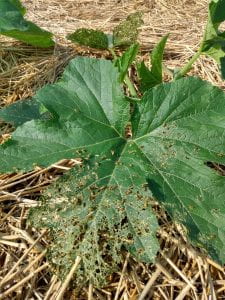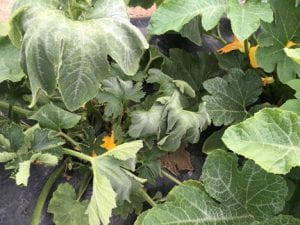Abby Seaman, Marcus Lopez, Bryan Brown
In a research farm setting, unlike a commercial farm, we actually WANT pests to show up so we can conduct a trial. But sometimes we plant it and they don’t come….In fact, there’s a joke that if you want a pest to disappear for a season, just get a graduate student to start a research project.
Maybe because there aren’t any graduate students associated with this project, the insects, namely striped cucumber beetle and squash bug, showed up in impressive numbers this season. If you’re an organic squash grower, you probably know that there is not currently an effective insecticide for striped cucumber beetle that’s allowed in organic production. Many growers are using kaolin clay as a preventive treatment to deter feeding, and that’s what we did as well. Plants in the organic IPM subplots were treated with kaolin clay weekly until they reached the five-leaf stage when they become less susceptible to the bacterial wilt that striped cucumber beetles can transmit through their feeding. Because the plants in the different treatments were growing at different rates, the cultivated and black plastic treatments got one application, the straw mulch got two, and the rolled rye needed four.
Stay tuned for an upcoming post about squash bug!

Striped cucumber beetles often congregate on a single plant and reduce the leaves to lace.

Bacterial wilt introduced by striped cucumber beetle feeding

That ghostly look of a plant treated with kaolin clay to deter striped cucumber beetle feeding
